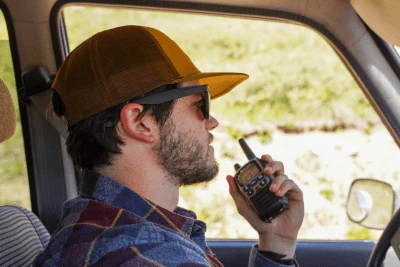FRS, GMRS, CB, HAM- What's the Difference and What to Choose?

Table of Contents
There are several different types of radios with different features, frequencies, and maximum power ranges.
As a leader in two-way radio technology, Midland Radio shares what you need to know about the different types of radio and how you can choose which is best for you.
ABOUT FRS
Family Radio Service, or FRS operates on the FM mode.
According to the Federal Communications Commission (FCC), it's a private, two-way, short-distance voice and data communications service to be used for facilitating family and group activities.
FRS is license free so users don't have to worry about that.
This type of radio operates on 22 channels and all are shared with GMRS two-way radios. Within these frequencies, anything two watts and under is considered FRS.
The most common use of FRS two-way radios is through handhelds like walkie talkies. Most likely, the walkie talkies you purchase from any sporting goods store are FRS.
ABOUT GMRS
General Mobile Radio Service (GMRS) operates on the FM mode.
According to the FCC, GMRS is a licensed radio service commonly used for short-distance two-way voice communication using handheld radios, mobile radios, and repeater systems.
The FCC does require a license, but it's super easy to apply, lasts 10 years, is only $35, and covers you entire immediate family.
GMRS two-way radios operate on 30 channels, 22 of which are the same as FRS. GMRS and FRS work on the same frequencies, but anything over two watts is considered GMRS. The maximum power allowed by law for GMRS two-way radios is 50 Watts.
Midland Radio is a leader in GMRS two-way radio technology with its MicroMobile® line.
ABOUT CB
Citizens Band Radio (CB) was created in 1945.
While this type of radio was initially used by the government, more and more civilians began using CB radios in the 1960's. CB radios rose to fame in the 1970's through pop culture.
CB radios operate on 40 shared channels in the AM mode. The maximum power levels for this radio transmission is four watts.
CB radios are intended for short range transmissions, but with antennas you can increase range.
A license is not required in order to operate a CB radio.
ABOUT HAM
Ham radio is also known as amateur radio.
According to the FCC, Ham radio is for qualified people of any age who are interested in radio use with a personal interest, without financial or business use.
29 small frequency bands throughout the spectrum allow this type of radio to reach across the world.
The FCC does require a license for users in the United States. Before you receive a license, you must pass a test administered by a team of volunteer examiners. These volunteer examiners will determine which license operator class you qualify for. Users must pay $35 for the license.
CHOOSING THE RIGHT TYPE OF RADIO
While each type of radio has its pros and cons, finding the right radio is key to your communication success.
OVERLANDING/OFF-ROADING
While many off-road and overlanding groups originally used CB radios to keep communication open along the trails, a majority have made the switch to GMRS. This can be attributed to both range and clarity.
CB radio operates on the AM mode which is why users experience the famous CB static. GMRS operates on the FM mode, bringing clear and crisp sound quality.
While GMRS can operate up to 50 Watts of power under law, CB radio can go up to a maximum of four watts of power. This means with a 50 Watt GMRS radio, overlanders/off-roaders can utilize over 12 times the power than they would with a CB radio.
Because GMRS two-way radios are compatible with FRS two-way radios, it's prudent because those new to radios will often pick up a set of walkies from a sporting goods store, most likely FRS. This way, off-roaders can keep connected with the entire group.
AGRICULTURE
Reaching one another on sprawling properties like ranches and farms is crucial to both safety and efficiency.
These properties typically have little to no cellphone service so two-way radios provide seamless, instant communication those on the farm can count on.
Many farmers once had CB radios, but are now looking to take their communication to new levels as new technology becomes available. Enter GMRS two-way radio.
Farmers are making the switch to GMRS because it can be easy to use, power stretches for further range, brings unprecedented voice clarity, is compatible with FRS, and more.
Many grain elevator operators still use CB radios so a lot of farmers are keeping both GMRS and CB radios in their vehicles.
CAMPING/HIKING/OUTDOORS
While hitting the trails and spending time at the campground, you're likely to run into communication issues with spotty cellphone service. It's also likely your group might want to split up at some point to explore all the great outdoors has to offer.
Simply pass out a set of walkie talkies for instant communication that's easy to use.
Most walkie talkies you pick up at the store or through Midland Radio are FRS, but some are GMRS. Both of these are simple and are compatible with one another so your entire family can just grab and go!






















